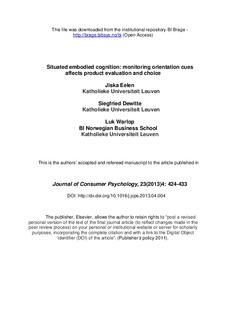| dc.contributor.author | Eelen, Jiska | |
| dc.contributor.author | Dewitte, Siegfried | |
| dc.contributor.author | Warlop, Luk | |
| dc.date.accessioned | 2013-11-01T13:24:53Z | |
| dc.date.available | 2013-11-01T13:24:53Z | |
| dc.date.issued | 2013 | |
| dc.identifier.issn | 1532-7663 | |
| dc.identifier.uri | http://hdl.handle.net/11250/93792 | |
| dc.description | This is the authors’ accepted and refereed manuscript to the article | no_NO |
| dc.description.abstract | Consumers generally prefer products that are easy to interact with. In three studies, we show that this preference arises from the fit between product orientation and monitored situational constraints. Flexible right-handers, who monitor situational constraints, recall product orientations better and prefer products for which the handle is oriented in the direction of the hand used for grasping. When their ability to monitor situational constraints is impaired, the preference for easy-to-grasp products is attenuated. The findings highlight that motor fluency is a relevant cue for decision making when consumers assess how to interact with a product. The implications of these results for embodiment and fluency research are discussed. | no_NO |
| dc.language.iso | eng | no_NO |
| dc.publisher | Elsevier | no_NO |
| dc.subject | embodiment | no_NO |
| dc.subject | situated cognition | no_NO |
| dc.subject | handedness | no_NO |
| dc.subject | processing fluency | no_NO |
| dc.subject | product orientation | no_NO |
| dc.subject | grasping | no_NO |
| dc.title | Situated embodied cognition: monitoring orientation cues affects product evaluation and choice | no_NO |
| dc.type | Journal article | no_NO |
| dc.type | Peer reviewed | no_NO |
| dc.source.pagenumber | 424-433 | no_NO |
| dc.source.volume | 23 | no_NO |
| dc.source.journal | Journal of Consumer Psychology | no_NO |
| dc.source.issue | 4 | no_NO |
| dc.identifier.doi | 10.1016/j.jcps.2013.04.004 | |
